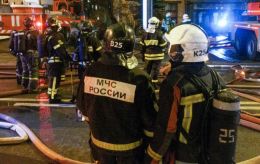North Korea expands factory making ballistic missile used by Russia, Reuters
 Photo: North Korea will increase missile production for Russia (from open sources)
Photo: North Korea will increase missile production for Russia (from open sources)
North Korea is expanding a key weapons production facility where short-range missiles are assembled that Pyongyang has supplied to Moscow, Reuters reports.
The facility, known as the February 11 plant, is part of the Ryongsong Machine Complex in Hamhung, North Korea's second-largest city, located on the country's eastern coast.
Sam Lair, a research associate at the James Martin Center for Nonproliferation Studies (CNS) at the Middlebury Institute of International Studies in Monterey, stated that this plant is the only known site producing the Hwasong-11 class of solid-fuel ballistic missiles.
According to CNS researchers' analysis, satellite images from early October, taken by commercial satellite company Planet Labs, reveal the construction of what appears to be an additional assembly building as well as a new residential complex likely intended for workers.
It also seems that Pyongyang is improving access to underground facilities at the complex.
Lair noted that an old bridge crane, previously blocking the entrance to a tunnel, has been removed, which suggests that this area of the facility might now be a focus of activity.
"We see this as a suggestion that they're massively increasing, or they're trying to significantly increase, the throughput of this factory," said Lair.
The new assembly building is about 60–70% smaller than the facility previously used for missile assembly.
In 2023, North Korean state media released images showing leader Kim Jong Un inspecting new buildings at the Hamhung complex. Analysts believe workers there assemble tail kits and nose cones for what appeared to be the KN-23.
Lair also explained that past North Korean state media footage indicated the facility produces a wide range of items, from tank wheels to missile motors casings.
Missiles designed to fly lower
According to the experts, the KN-23 missiles were first tested in May 2019 and are designed to bypass missile defense systems by flying at lower, "depressed" trajectory. This capability is potentially advantageous for Russia, which is seeking ways to counter Ukraine's air defenses.
Since the start of its invasion, Russia has launched thousands of missiles at Ukraine. Relying on North Korea for additional supplies could ease the strain on its own production capacity, Lair noted.
Researchers from SI Analytics, a South Korean satellite imaging analysis company that uses AI, also confirmed new construction at the February 11 plant. Their report suggests part of the structure near the loading area is likely intended to conceal the facility's future activities from satellite observation.
"Considering the presence of numerous construction materials, vehicles, and open-top freight cars loaded with materials around the site, the construction appears to be progressing rapidly," the firm stated. While the facility is known to produce ballistic missiles, the report did not specifically mention the KN-23 designation.
North Korean missiles account for only a small portion of Russia's strikes in the war against Ukraine. However, their use has raised concerns in Seoul and Washington, as it marks the end of a nearly two-decade consensus among UN Security Council permanent members to prevent Pyongyang from expanding its ballistic missile programs.
According to Kyiv, North Korea has supplied Russia with 194 KN-23/KN-24 ballistic missiles. Since the beginning of 2024, Russia has launched approximately 60 North Korean KN-23 missiles at Ukraine.

